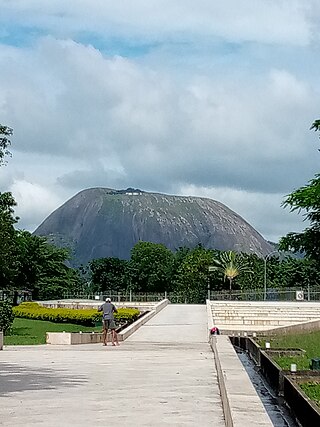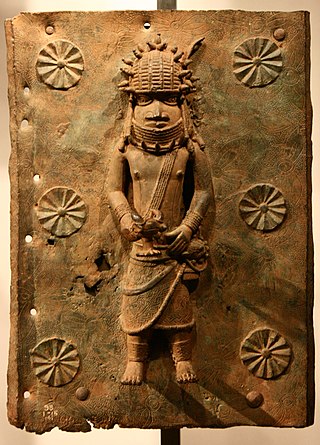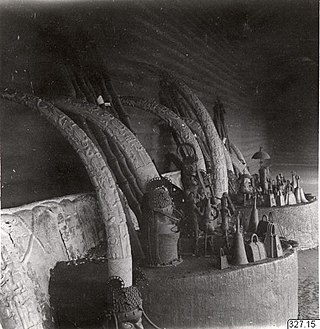Related Research Articles

The history of Nigeria can be traced to the earliest inhabitants whose remains date from at least 13,000 BC through early civilizations such as the Nok culture which began around 1500 BC. Numerous ancient African civilizations settled in the region that is known today as Nigeria, such as the Kingdom of Nri, the Benin Empire, and the Oyo Empire. Islam reached Nigeria through the Bornu Empire between and Hausa Kingdom during the 11th century, while Christianity came to Nigeria in the 15th century through Augustinian and Capuchin monks from Portugal to the Kingdom of Warri. The Songhai Empire also occupied part of the region. Through contact with Europeans, early harbour towns such as Calabar, Badagry and Bonny emerged along the coast after 1480, which did business in the transatlantic slave trade, among other things. Conflicts in the hinterland, such as the civil war in the Oyo Empire, meant that new enslaved people were constantly being "supplied".
The Benin Expedition of 1897 was a punitive expedition by a British force of 1,200 men under Sir Harry Rawson. It came in response to the ambush and slaughter of a 250 strong party led by British Acting Consul General James Phillips of the Niger Coast Protectorate. Rawson's troops captured Benin City, bringing to an end slavery and human sacrifice in Benin, and indeed the Kingdom of Benin itself, which was eventually absorbed into colonial Nigeria. The expedition freed slaves held by the Oba.

The Oba of Benin is the traditional ruler and the custodian of the culture of the Edo people and all Edoid people. The then Kingdom of Benin has continued to be mostly populated by the Edo.

The Benin Bronzes are a group of several thousand metal plaques and sculptures that decorated the royal palace of the Kingdom of Benin, in what is now Edo State, Nigeria. Collectively, the objects form the best examples of Benin art and were created from the fourteenth century by artists of the Edo people. The plaques, which in the Edo language are called Ama, depict scenes or represent themes in the history of the kingdom. Apart from the plaques, other sculptures in brass or bronze include portrait heads, jewelry, and smaller pieces.

Lieutenant Colonel Sir Henry Lionel Galway, was a British Army officer and the Governor of South Australia from 18 April 1914 until 30 April 1920. His name was Henry Lionel Gallwey until 1911.

Oba Ovonramwen Nogbaisi, also called Overami, was the thirty-fifth Ọba of the Kingdom of Benin reigning from c. 1888 AD – c. 1897 AD, up until the British punitive expedition.

The Esan people are an ethnic group of southern Nigeria who speak the Esan language. The Esan are traditionally known to be agriculturalists, trado-medical practitioners, mercenary warriors and hunters. They cultivate palm trees, Irvingia gabonensis (erhonhiele), Cherry (Otien), bell pepper (akoh) coconut, betel nut, kola nut, black pear, avocado pear, yams, cocoyam, cassava, maize, rice, beans, groundnut, bananas, oranges, plantains, sugar cane, tomato, potato, okra, pineapple, paw paw, and various vegetables.

Louis Delgrès was a leader of the movement in Guadeloupe resisting reoccupation and thus the reinstitution of slavery by Napoleonic France in 1802.

Benin art is the art from the Kingdom of Benin or Edo Empire (1440–1897), a pre-colonial African state located in what is now known as the Southern region of Nigeria. Primarily made of cast bronze and carved ivory, Benin art was produced mainly for the court of the Oba of Benin – a divine ruler for whom the craftsmen produced a range of ceremonially significant objects. The full complexity of these works can be appreciated through the awareness and consideration of two complementary cultural perceptions of the art of Benin: the Western appreciation of them primarily as works of art, and their understanding in Benin as historical documents and as mnemonic devices to reconstruct history, or as ritual objects. This original significance is of great importance in Benin.

A punitive expedition is a military journey undertaken to punish a political entity or any group of people outside the borders of the punishing state or union. It is usually undertaken in response to perceived disobedient or morally wrong behavior by miscreants, as revenge or corrective action, or to apply strong diplomatic pressure without a formal declaration of war. In the 19th century, punitive expeditions were used more commonly as pretexts for colonial adventures that resulted in annexations, regime changes or changes in policies of the affected state to favour one or more colonial powers.

The Kingdom of Benin, also known as the Edo Kingdom or Benin Kingdom, is a kingdom within what is now southern Nigeria. It has no historical relation to the modern republic of Benin, which was known as Dahomey from the 17th century until 1975. The Kingdom of Benin's capital was Edo, now known as Benin City in Edo State, Nigeria. The Benin Kingdom was "one of the oldest and most developed states in the coastal hinterland of West Africa". It grew out of the previous Edo Kingdom of Igodomigodo around the 11th century AD, and lasted until it was annexed by the British Empire in 1897.

Benin ancestral altars are adorned with some of the finest examples of art from the Benin Kingdom of south-central Nigeria.

The Benin ivory mask is a miniature sculptural portrait in ivory of Idia, the first Iyoba of the 16th century Benin Empire, taking the form of a traditional African mask. The masks were looted by the British from the palace of the Oba of Benin in the Benin Expedition of 1897.

Esanland, otherwise known as Esan Nation, is a cultural region located in Edo State, Nigeria. It is composed of five Local Government Areas in Edo State. Esanland lies west of the banks of the Niger River. It is bordered by Kogi State, Delta State, Edo South Senatorial District, and Edo North Senatorial District. Esanland covers about 2,800 square kilometers and is home to over half a million people. The Esan people and culture of Esanland are generally homogenous.
Chief Agho Obaseki was a paramount Chief in the Benin Empire from 1898 to 1914, and then Iyase of Benin from 1914 until his death in 1920.

James Robert Phillips was the deputy commissioner and consul for the Niger Coast Protectorate. He is remembered for his part in the events that led to the Benin Expedition of 1897. In 1897, Phillips set out to petition the Oba of Benin, although his reasons for doing so remain unclear. He and his party were ambushed and slaughtered as they approached Benin City, with Phillips being among the casualties. Though Phillips had acted without consulting the Royal Niger Company authorities, after his death the British government dispatched an punitive expedition against the Benin monarchy, which the force defeated and deposed, leading to the kingdom's eventual absorption into colonial Nigeria.

Aiguobasinwin Ovonramwen, Eweka II was the thirty-sixth Oba of Benin, reigning from 1914 to 1933.

Izevbokun Oshodin was a chief in the ancient Benin Empire in Edo State of Nigeria. He was one of the loyal lieutenants of Oba (king) Ovonramwen, the exiled ruler of Benin who worked with the British colonial authorities to administer what was left of the ancient kingdom of Benin after the Benin Massacre and the subsequent military operation against Benin that destroyed most of the city in 1897. He was first appointed a Warrant Chief and member of the Native Council constituted by the new British Resident. He was later appointed District Head of Benin Districts by the British colonial government from 1914-1924 and served as the District Head of Benin City from 1924-1929. He died on 11 April 1929 in Benin City during the reign of Oba Eweka II.

The Akure–Benin War in 1818 was a conflict between the Benin Kingdom and the Akure Kingdom in what is now Nigeria. The origins of this conflict can be traced to the complex history of the region, with Akure being a place of ancient settlements, some dating back to the early Ife kingdom. The Akure Kingdom emerged when these communities were consolidated under the rule of Prince Omoremilekun, who descended from Oduduwa, a revered figure in Yoruba history. Historically, the relationship between Benin and Akure had been marked by peace and mutual respect due to shared cultural heritage and ancestry.
Asoro, also known as General Asoro was a war chief in the Kingdom of Benin who served as the sword bearer to Oba Ovonramwen during the 1897 British expedition to Benin. He participated in the defense of Benin against the British expeditionary force that aimed to capture the Oba. Asoro's statement "no other person [should] pass this road except the Oba" resulted in the naming of a road in Benin as "Sakponba".
References
- ↑ "Group honours victims of British expedition in old Benin kingdom". The Street Journal. January 13, 2019.
- ↑ "Measures of Power: Our interest in violent, public justice". The Mail & Guardian. 2020-06-04. Retrieved 2023-05-06.
- ↑ Taylor, Mildred Europa (2020-07-13). "This army chief fought against invasion of Benin kingdom but was betrayed by his own and hanged". Face2Face Africa. Retrieved 2023-05-06.
- ↑ Francis, Onoiribholo (Jan 14, 2019). "Group Honours Fallen Benin Heroes". Independent.
- ↑ "Ovonramwen | king of Benin | Britannica". www.britannica.com. Retrieved 2023-05-06.
- ↑ Taylor, Mildred Europa (2020-07-13). "This army chief fought against invasion of Benin kingdom but was betrayed by his own and hanged". Face2Face Africa. Retrieved 2023-05-06.
- ↑ Taylor, Mildred Europa (2020-07-13). "This army chief fought against invasion of Benin kingdom but was betrayed by his own and hanged". Face2Face Africa. Retrieved 2023-05-06.
- ↑ "Measures of Power: Our interest in violent, public justice". The Mail & Guardian. 2020-06-04. Retrieved 2023-05-06.
- ↑ "ExecutedToday.com » 1899: Ologbosere, of the Benin Empire". 28 June 2011. Retrieved 2023-05-06.
- ↑ Taylor, Mildred Europa (2020-07-13). "This army chief fought against invasion of Benin kingdom but was betrayed by his own and hanged". Face2Face Africa. Retrieved 2023-05-06.
- ↑ "Measures of Power: Our interest in violent, public justice". The Mail & Guardian. 2020-06-04. Retrieved 2023-05-06.
- ↑ Taylor, Mildred Europa (2020-07-13). "This army chief fought against invasion of Benin kingdom but was betrayed by his own and hanged". Face2Face Africa. Retrieved 2023-05-06.
- ↑ "Measures of Power: Our interest in violent, public justice". The Mail & Guardian. 2020-06-04. Retrieved 2023-05-06.
- ↑ "photographic print (black and white) | British Museum". The British Museum. Retrieved 2023-05-06.